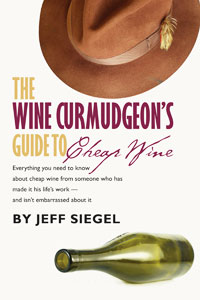Tag: wine ratings
Wines that Won’t Break the Bank
Cheap Wine By Jeff Siegel
If you’re serious about wine, then Jeff Siegel’s volume on inexpensive value wine isn’t the only book you need to read. But you might be better off if it’s the first one you read, and the wine-consuming world might be a better place if everyone did the same.
Why? Because Mr. Siegel, known to fans of his blog as “The Wine Curmudgeon,” dispenses with the “wine-speak” blather that is meant to intimidate consumers and offers instead the  radical notion that it’s okay to like wine that doesn’t cost a lot. Not that there’s anything wrong with an expensive Bordeaux – depending upon the bottle, there will probably be a great deal to like about it – but it’s important for novices to recognize that “Cheap Wine” can be good wine. In fact, winemaking and viticulture techniques have improved to the point that the least expensive bottle of wine on the shelves at Costco or Trader Joe’s will likely be at least drinkable, if not actually enjoyable. And with a little care, you can pick wine that is both inexpensive and good.
radical notion that it’s okay to like wine that doesn’t cost a lot. Not that there’s anything wrong with an expensive Bordeaux – depending upon the bottle, there will probably be a great deal to like about it – but it’s important for novices to recognize that “Cheap Wine” can be good wine. In fact, winemaking and viticulture techniques have improved to the point that the least expensive bottle of wine on the shelves at Costco or Trader Joe’s will likely be at least drinkable, if not actually enjoyable. And with a little care, you can pick wine that is both inexpensive and good.
“Wine doesn’t have to cost a lot of money to be enjoyable,” he writes. “Call it cheap. Call it inexpensive. Call it a value wine. But whatever you call it, it doesn’t have to be expensive. Just $10 – and often less – will buy a perfectly acceptable and often excellent bottle of wine.”
What I like most about Mr. Siegel’s approach is that he makes wine approachable for folks that might otherwise stick with beer or vodka. Wine can be intimidating for the newcomer, and too many wine writers, sommeliers, and even the staff in tasting rooms seem to delight in making in making wine something of a black art that only the initiated can understand.
As I write this, I’m sipping a $14 bottle of 2009 Barolo that I bought at Trader Joe’s. As it happens, I had purchased this wine a few months ago and discovered last week when I opened it that it was “corked,” which is to say, inflicted with that wet-dog smell that comes from TCA taint. I returned it to TJs, and without asking a question, they replaced the bottle. So here’s a little side note: trust yourself, and don’t be afraid to return a bottle that you think is corked or which otherwise suffers from a real wine flaw. Chances are, the guy behind the counter knows less than you do about wine.
The replacement bottle was wonderful, and that brings me back to the real point of this story, which is that wine need not be expensive to be good. Sometimes, in fact, cheaper is better — for reasons that go beyond the obvious. Continue Reading–>
WBC11: A Conference for Wine Bloggers -Part II
When I signed up for the North American Wine Bloggers Conference, I had just assumed, without really giving it much thought, that it would be a conference mostly about the art and practice of blogging, made into a wine blogger conference by the shared interest of those attending. In fact, it was mostly about wine, with a few sessions devoted to the practice of blogging.
Thank God for that.
What was I thinking? Of course, it should be about the wine. After all, I get a regular stream of solicitations at the office for conferences focused on the how-to of social media, so that market is apparently covered. The wine blogger conference market, however, is another story, and WBC11 catered to it in so many ways, especially by providing am abundance of opportunities to taste wines – Virginia wine in particular, I’m happy to say – and hear from the men and women who grew the grapes and turned them into wine. That’s something you just can’t get just anywhere else. Continue Reading–>
2010 Chateau Pavie: A Wine that is either Amazing or Awful
Eric Asimov, the New York Times wine critic, blogged last week about a controversy over the 2010 Chateau Pavie, which is considered one of the great wines from St. Emilion. In his May 24 post, Mr. Asimov compares Robert Parker's rave review of the wine (tasted as a barrel sample) with that of John Gilman, whose web-only publication, A View from the Cellar, represents a new generation of wine criticism.
So, two critics, one wine. You'd think the reviews would at least be in the same ballpark. But you'd be wrong. Parker rates it as nearly perfect, and Gilman describes it as "absurdly overripe, unpleasant to taste and patently out of balance." And that's just for starters. Continue Reading–>
Books: How Robert Parker Overthrew the Wine Establishment
The Emperor of Wine: The Rise of Robert M. Parker, Jr., and the Reign of American Taste
It’s hard to overestimate Robert Parker’s influence on the wine we drink. Best known for developing the 100-point rating system, Parker’s Wine Advocate newsletter became so influential that winemakers consciously made wines to suit his taste for big, high-alcohol wines with power and intensity. Consultants that he was known to like were in high-demand by wineries, and wines that he praised in the Wine Advocate could sell out almost as soon as they arrived in stores. Continue Reading–>



Recent Comments